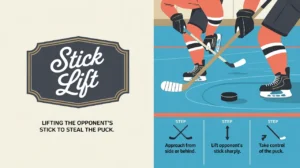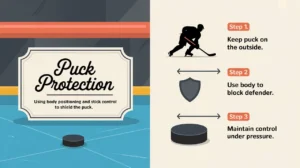Jim’s Intro to Positioning & Angles
Hi folks, Jim here, the only commentator who once tried to play the angles as goalie and got his skates all tied up in the net. I’m the one who needed to be saved in the end.
What is positioning and angles?
Positioning and angles refer to a goalie’s ability to align their body with the puck’s trajectory and the net so that they cover as much scoring area as possible. Instead of relying on wild reactions, goalies use geometry and anticipation to make saves look easy.
How does it work?
Positioning and angles rely on precise movement, visual tracking, and body alignment:
- Square to the Puck: Always face the puck directly, not just the player.
- Center on the Shot Line: Position yourself so a line from the puck to the middle of the net runs through your chest.
- Adjust with the Puck: Move in controlled shuffles as the puck changes location.
- Depth Control: Step out to cut angles on shooters, retreat to react to passes.
- Post Integration: Use the posts to seal off tight angles and wraparounds.
- Consistent Stance: Maintain a steady stance that allows quick movement in any direction.
How do you make good decisions with it?
- Read the Play Early: Anticipate where the puck will move to set up before the shot.
- Balance Aggression and Patience: Challenge when appropriate, hold depth when traffic or passes threaten.
- Stay Centered: Avoid drifting or leaning, which opens up gaps.
- Adapt to Shooters: Recognize tendencies to adjust angles dynamically.
- Use Landmarks: Goalies often use the crease markings or posts as visual cues to stay oriented.
How do you master it?
Mastering positioning and angles takes repetition, game awareness, and technical precision. Goalies drill angle plays from different spots, practice controlled depth adjustments, and watch film to sharpen their reads.
What does it look like when done right?
Excellent positioning and angles look effortless and clean. Shooters see no open net, the goalie is already square, and saves happen without desperate lunges.
Commentator’s Corner
Jim’s Take
Good positioning is like playing chess three moves ahead. The puck hasn’t even left the stick, and the goalie’s already exactly where it needs to be.
Parent Tip
Focus on movement fundamentals early. Great positioning makes even average goalies look outstanding.
Player Tip
Goalies, let the puck come to you. Shooters, find creative ways to change angles. Good positioning eats up straight shots.
A Final Thought
Positioning and angles are the foundation of elite goaltending. Master them, and you’ll make the net look tighter, the saves cleaner, and the game slower in the best possible way.









